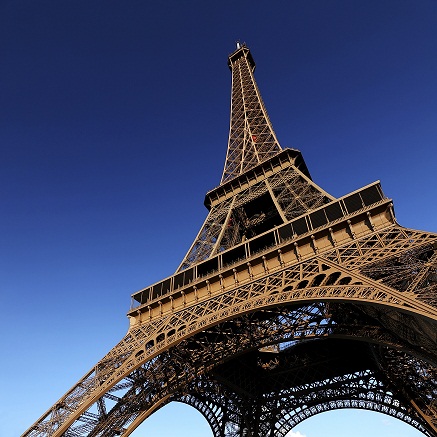The Eiffel Tower Turns 125
The world’s most visited man-made monument just turned 125.
Built for the Paris World’s Fair of 1889, French engineer Gustave Eiffel’s famous tower attracted only scorn before it opened. Prominent literary figures published a letter of protest in a leading newspaper decrying the “barbarous mass” that overwhelmed the city’s historic buildings and threatened its cultural treasures. Critics sneered at “this truly tragic street lamp” and “mast of iron gymnasium apparatus, incomplete, confused and deformed” they had dubbed the Tower of Babel.
The Eiffel Tower‘s instant popularity – some 2 million people visited during the five-month World’s Fair – soon silenced the sniping.
Engineering and science also have contributed to the Tower’s longevity.
Until the Chrysler Building went up in Manhattan 41 years later, the Tower was the world’s tallest structure. At 984 feet, it dwarfed the previous record holder — the 555-foot Washington Monument. Its iron-lattice design allowed for height without sacrificing strength, and was a revolution in structural engineering. Click here for more fun Tower facts from Science for Kids.
 The Tower also became a lab for such emerging fields as aviation and telecommunications. The day after opening his building to the public, Eiffel installed weather instruments, including a giant manometer that could measure air pressure that was 400 times greater than at ground level, on the third (the highest) floor and wired them to the French weather bureau in Paris. He used his own funds to publish weather maps and charts.
The Tower also became a lab for such emerging fields as aviation and telecommunications. The day after opening his building to the public, Eiffel installed weather instruments, including a giant manometer that could measure air pressure that was 400 times greater than at ground level, on the third (the highest) floor and wired them to the French weather bureau in Paris. He used his own funds to publish weather maps and charts.
In designing his 10,000-ton Tower, Eiffel took wind into account. But he also was interested in aviation. In 1903, the year the Wright brothers flew the first motorized airplane, he began studying the motion and aerodynamics of objects racing down a cable from the Tower’s second floor. Scientific American reported on one of these early experiments in its March 19, 1904, issue. His finding that resistance increases in proportion to the square of the object’s surface helped guide the design of aircraft wings. So did the wind tunnel Eiffel built at the Tower’s base.
The four-legged iron archway was supposed to last only 20 years, when the Tower’s operating permit would expire. In late 1898, Eiffel invited inventor Eugène Ducretet to conduct experiments in radio communication from the third floor. The first wireless telegraph transmission in France took place on November 5. A year later, France and England could communicate via radio waves.
Eager to prevent the city from tearing down his spire, in 1903 Eiffel asked the army to research the new field of radio communications – and covered the costs. By 1908, the Tower was broadcasting wireless telegraph signals from a permanent transmitter to ships and military stations as far away as North America and Africa. In 1910, the city of Paris renewed the Tower’s lease for 70 years, ensuring the landmark would endure.
Since then, the Tower’s telecommunications role has including intercepting World War I spies and broadcasting France’s first radio music and TV shows.
To mark its 125th anniversary, the iconic tower got a face lift that includes glass floor panels in four new viewing sections on the first floor, the Telegraph reports.
A recent analysis commissioned by the firm that now operates the Eiffel Tower concluded nothing – including extreme winds or weather – should prevent it lasting another two or three centuries.
Catch an eagle’s eye view – literally – from the Eiffel Tower:
[youtube]http://www.youtube.com/watch?v=NXOlzUz_7qI[/youtube]
Filed under: Special Features
Tags: Civil Engineering, construction, Eiffel Tower, Gustave Eiffel, Structural Engineering, tower









